
(Booklife in an alternative universe.)
Master designer John Coulthart created Booklife‘s distinctive cover. But what that final cover can’t show readers is the long, drawn out process of getting to a great cover. That process was partly my fault and partly an inherent problem in creating something unique for a writer’s manual. After finalizing Booklife, Coulthart wrote about the experience, including several cover drafts from along the way. In doing so, he gives an interesting and invaluable behind-the-scenes perspective. For your enjoyment, and those who might’ve missed it, we reproduce his original post below the cut.
DESIGNING BOOKLIFE
by John Coulthart
I created a cover design recently for Jeff VanderMeer’s new novel, Finch, and shortly after completing that Jeff asked if I could put together some cover ideas for his forthcoming writer’s guide, Booklife, which Tachyon will be publishing later this year. Jeff is known as a fantasy writer but this book was intended to have a general appeal for any would-be or working writer. It also needed to look suitably contemporary and (possibly) reflect the discussion within which concerns the modern writer’s use of computers, the internet and social networks. Lastly, several lines of text needed to be placed on the cover without it looking confused or messy.
I agreed to this whilst busy with several other projects so the initial drafts were rather haphazard. (That’s my excuse, anyway.) The first version (above) came out of an idea to apply a kind of trompe l’oeil effect to the cover with a torn dustjacket and handwritten amendments. The red call-out/roundel highlights an important sub-section of the book. This was knocked up very quickly and, as well as not looking very contemporary, the title doesn’t look enough like gold blocking to be convincing. Jeff requested something more up-to-date.

Version 2 was a hasty attempt to get contemporary although this looks too bland and sterile, like a business primer or a university press book. We’d talked about trying to convey the nature of electronic networks without resorting to the internet clichés of the Nineties, hence the connected books in the background. I was thinking of the kind of clear-line illustration you get in some European comics but this turned out to be one of those ideas which seem good in the abstract yet trying to get it to work turns out to be a) difficult and b) not such a good idea after all. The background quickly became crowded and confused when trying to convey any kind of depth. This cover has the first appearance of one of my sunbursts, a habitual motif I’m guilty of using in places where it doesn’t always belong. I blame a Catholic upbringing which left me with a halo obsession.
Jeff wasn’t keen on this either so he suggested I go back to the first version but show an old Victorian book design ripped away to reveal something contemporary underneath. He mentioned William Morris designs but I didn’t think they would be suitable; Morris’s books have beautiful elaborate borders but their layout follows the medieval page grid which is asymmetrical. I wanted something equally elaborate but with suitable symmetry.
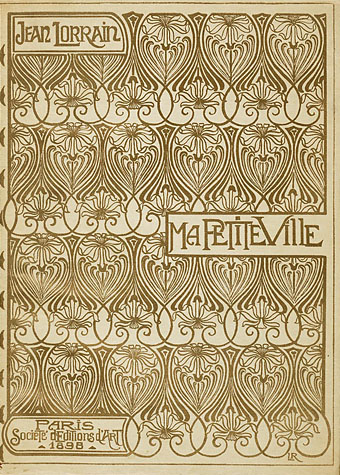
A bit of web searching turned up a Jean Lorrain cover by Léon Rudnicki which I have in a book of art nouveau design but at a size too small to be usable. It took a fair amount of work to refashion a medium-res jpeg into the vector version below.


Some additional work in Photoshop and we had something which looked like an old cover blocked in gold.

Which was then ripped away to reveal a new version of the earlier bland cover. A globe has been introduced as a new feature although I warned about globes being too closely associated with travel books.
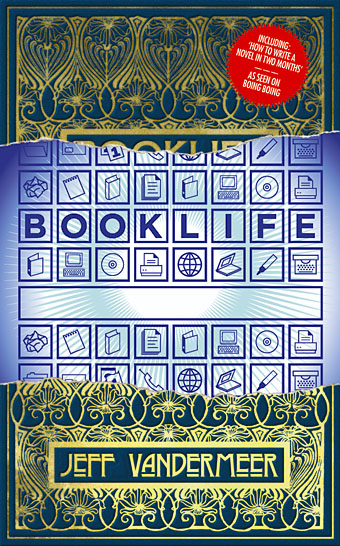
An unfinished draft. Jeff suggested changing the green cover to blue and he wasn’t keen on the diagonal tear so this was made horizontal. By this point I’d decided to get rid of the networked books and replace them with symbols that convey the digital world. Ideally you’d want to spend some time creating symbols like this yourself but I still had too many other things on the go so these are taken from a Linotype set of office dingbats. Some of these are now distinctly dated, there’s a floppy disc (which I didn’t use) and the computer monitor has a curved edge to the screen like an old TV. The sunburst is still hanging in there but has turned blue. In design terms blue often signifies the future (in a cold electronic sense) in the same way that sepia signifies the past.

Another unfinished draft which attempted to combine the symbols with the globe. Jeff liked this but I didn’t, I felt that attempting to combine two very different covers had led us astray. Jeff was still eager to convey a sense of modernity or even the future and I thought this would be difficult. In the 1990s there was a well-defined sense of futurity attached to anything cybernetic or computer-oriented. That idea and its attendant imagery is now thoroughly outmoded, computer technology is so embedded in our lives that we barely notice it. Our phones are as powerful as home computers were a decade ago. In graphic design terms there’s currently no shorthand (apart from vague blue tones) that says “the future”, not least because people aren’t sure what the future will be or if there’ll be one that anyone actually wants to live in.
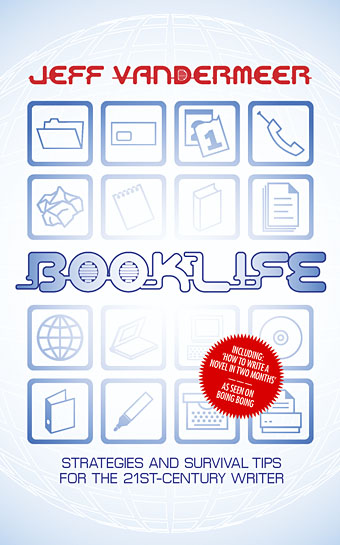
So the torn book was scrapped but I kept the globe and some of the office symbols. The roundel still persists. I picked out a distinctive typeface for the title although if we’d have gone with this as the final cover I would have removed the filler elements from the O and the D.

Jeff thought this was okay but asked to see the globe brought back so here it is along with the returning sunburst.

I think this was the one which Jeff liked most of all but I didn’t although the colours at least blend together. I felt we were still at the cold business end of things and suggested scrapping all of these approaches and trying something new.
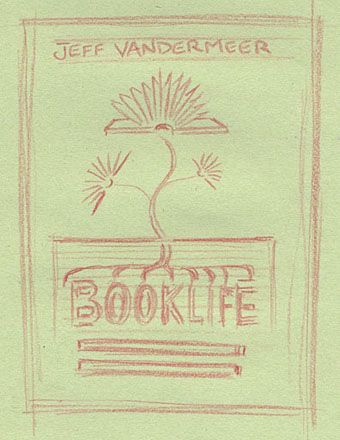
Which is what I did. Jeff had earlier suggested growing roots although I couldn’t see how that could be easily reconciled with the digital networks aspect. USB cables as roots? Hmm… Whilst pondering this one of those flashes of inspiration occurred which I immediately sketched and emailed. I knew this would look good if it was done as a very clean vector layout—a cross-section of earth with the title putting out roots and books blooming from a plant stem. Jeff liked it so I set to work.
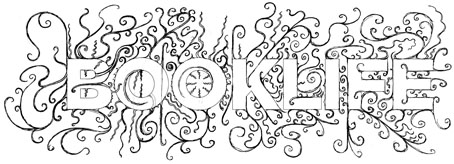
First thing to do was to get the title right which involved printing out the type at large size then drawing the roots with a pencil.

Next I needed a suitably stylised plant and came across this very tiny motif in one of my design source books. This was from an art nouveau border design so a trace element of older book styles would still be present. All that was required now was to put the various elements together.

(Original draft–final differed slightly)
And here’s the result which finally pleased everyone. Slightly different to the sketch since I decided to borrow a trick from designer Barney Bubbles and make the book flowers and the title lettering form a face which gives an additional, subliminal quality to the title. I managed to get the sunburst in there with some justification at last—it adds depth and colour as well as being…the sun—and there was enough space for a quote at the top. All the type ended up as different weights of Helvetica. Watching the Brian Eno documentary last night I was struck by his comment that instruments today give you a vast array of sounds when all you really need are a handful of very good ones. The same applies to typefaces. I love typography, and enjoy seeing new designs appear, but despite the thousands of available typefaces you often come back to a small selection which do the job better than anything else. Helvetica is one of these.
This cover is a good example of how much the design process is about narrowing your range of options. Some of the blind alleys would have been avoided if we’d discussed ideas at length beforehand but we were both very busy and some of the intermediate stages only came together after playing around in Illustrator. This isn’t the first time I’ve had the flash of inspiration occur way down the line, sometimes all you can do is thrash around waiting for lightning to strike. I’m happy to say it usually strikes for me a lot earlier than this but as long as it keeps striking I don’t mind. As always, reaching the destination is the important thing, not how you get there.

Fascinating. Thanks for sharing this! Most people don't realize how much work goes into the cover design process.
Alas, the links to images are experiencing some issues–the source site has decided to go down periodically, so in a sec I'll be embedding the images. Thanks for your patience.
Fixed now–apologies.
Great stuff, Jeff. Thanks for sharing this.
Pingback: Various useful webbishry at Brenda Cooper
Very cool Jeff,
Thanks for sharing this post with us. I really liked reading about how John worked through the various steps it took him to create the cover.
Gives me an appreciation for the work the cover artists do for books and highlights your book more. Makes me more interested in this book and your work.
Really nice. Though, I suspect you are a very privileged writer. As far as I know the majority of writers have no say whatsoever about covers. Care to comment?
Very good point. "Privileged" is the wrong word, though, since it has other meanings. It's mostly because I have a strong visual sensibility and used to run an indie press where I worked closely with graphic designers and artists. So not only did I know some amazing people in the arts from whom I could draw for my own covers, I also knew how to present my ideas to publishers in such a way that it would be seen as useful and not obtrusive. About 95 percent of the covers of my books from indie and large publishers are either from my ideas or are from the ideas of designers that I worked with. As you can see with Booklife that's sometimes a bad thing. But in general the process goes much more smoothly.
In Booklife I recommend, though, that authors butt out of the cover process unless they have the necessary background and/or communication skills to not only make good recs but also to talk about those recs in a useful way with their editor.
Jeff